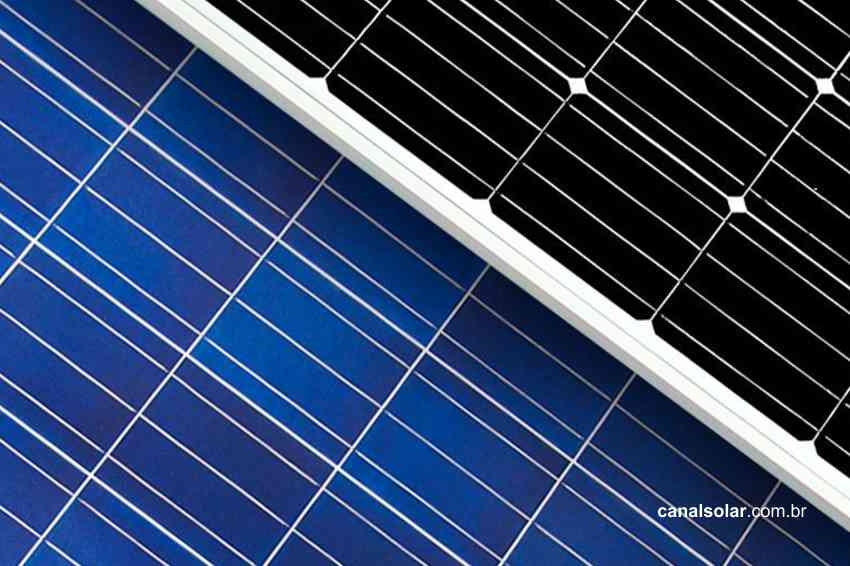In a previous article, I commented on the predominance of monocrystalline silicon over polycrystalline in the photovoltaic market, a trend that began around 2018 and is expected to increase in the coming years, according to projections from the world's main manufacturers of photovoltaic cells and modules (such as Jinko, Trina, Longi) and analyzes found in the market.
Polycrystalline silicon would have superior thermal behavior than monocrystalline silicon in Brazilian climatic conditions when we only analyze the semiconductor material.
But, when we analyze the characteristics of commercial photovoltaic cells and modules, this is not always true.
Given the scenario of the possible disappearance of polycrystalline silicon from the market, it is important to clarify for the Brazilian market that monocrystalline modules in our hot climate will have similar performance to polycrystalline modules, and may even be superior in some cases, as we will see below.
Thermal behavior of photovoltaic modules
Commercial crystalline photovoltaic modules have thermal coefficients that determine their performance in relation to operating temperature.
In some references we found results that indicate that polycrystalline presents better performance (less power reduction) with increasing temperature, while other studies say exactly the opposite.
In light of this doubt, it is worth highlighting that the thermal coefficients of photovoltaic cells and modules, whether mono or polycrystalline, are very similar.
The thermal coefficients (which we will talk about later) depend on several factors, from the type of material used in the cell to the way the module is constructed.
The coefficient that determines the variation of power with temperature depends on factors that affect the conduction of electrical current, including constructive characteristics of the cells, such as the resistance of electrical contacts.
So, we cannot say that one type of silicon is better than the other from the point of view of thermal behavior. For practical purposes, what matters are the thermal characteristics of commercially available modules.
In consultation with Jinko Solar's technical department, I obtained the following information when I questioned the origin of the low thermal coefficients of some monocrystalline modules
"With innovation in the manufacture of photovoltaic cells (such as the passivation layer to increase efficiency and new cells with a larger area) and innovation in the manufacture of modules (such as the half-cell technique) temperature coefficients have decreased drastically. Jinko's Cheetah and Swan families have the lowest thermal coefficients among the product portfolio, with values equal to -0.36%/°C. This provides good performance even at high temperatures.”
The figure below shows results of efficiency measurements carried out with three types of photovoltaic modules at different operating points.
The results show how the efficiencies of different technologies are impacted with increasing temperature.
The result of the study, carried out in a country with a tropical climate, shows that in the crystalline family, the best performance was achieved by monocrystalline silicon, while polycrystalline silicon showed a slightly more pronounced reduction in efficiency with increasing temperature.
Compare the red and green point clouds in the figure and observe how the points are lowered as the temperature (on the horizontal axis) increases.
In the graph below, we also find a cloud of blue points, which refers to the technology of thin films – which will not be covered in this article.
The conclusion is that the thermal behaviors of the two types of crystalline modules, mono and poly, are very similar.
In this particular study, monocrystalline silicon performed better, as the red dots are lowered at a slower rate than the green dots as the temperature rises.

Thermal coefficients of photovoltaic modules
We will now carry out an analysis of the technical characteristics of commercial photovoltaic modules, with information obtained from the manufacturers' data sheets.
Among the characteristics that we can find in the data sheets, the most important from a temperature point of view are the thermal coefficients.
Thermal coefficients determine the behavior of the photovoltaic modules' output variables (power, voltage and current) as a function of temperature. In the data sheets we find three coefficients. Are they:
Alpha
Coefficient that shows the variation of the short-circuit current of module ISC with the temperature. This coefficient is very small, practically negligible, and positive.
The fact that it is positive indicates that the module current increases with temperature. But since this coefficient is very small, it has little or no influence on the practical results of photovoltaic modules.
Beta
Coefficient that shows the variation in the open circuit voltage of the module Voc with the temperature. This coefficient is always a negative number, which indicates that the module's output voltage decreases with increasing temperature.
gamma
Coefficient that shows the variation in peak power of module PMPP with the temperature. This coefficient is also a negative number, which means that the module's power decreases as the temperature increases.
This coefficient reveals one of the main practical problems that affect the results obtained with photovoltaic modules. At high temperatures, some modules may suffer a greater or lesser reduction in power depending on the value of this coefficient.
This coefficient can be used as a means of comparison between modules from different models and different manufacturers. The lower the coefficient, the lesser the influence of temperature on the performance of the photovoltaic module (and the more electrical energy will be generated).
As we explained above, the Alpha, Beta and Gamma coefficients act on the output variables of the photovoltaic modules: ISC, VO.C., PMPP. If you still have questions about what these variables are, read the article Understanding the IV and PV curves of photovoltaic modules.
Thermal coefficients are expressed as a percentage per degree Celsius (%/OC ) or percentage per Kelvin (%/K), which is the same thing.
In other words, the coefficients reveal the percentage variation of some variable (current, voltage or power) of the module in relation to the temperature variation. In short, the coefficients show the decrease (in the case of voltage and power) or the percentage increase that the variable undergoes for each increase or decrease of 1OW.
Below we will analyze an example of application of the thermal power coefficient (Gamma).
A given photovoltaic module has a Gamma coefficient = -0.37%/OC. This means that the peak power of the module will decrease by 0.37% (relative to the power PMPP nominal) for each increase of 1OC at the operating temperature of photovoltaic cells.
Considering that the standard specification temperature of the modules is 25OC, a photovoltaic module with a nominal power of 330W, for example, operating at a temperature of 60OC would have a power reduction calculated as follows:
Power variation = (60 – 25) x -0.37% x 330W = -42.735W
According to the result above, this crystalline silicon module will lose 42.735W of its nominal power, a reduction of around 12%, when operating at a temperature of 60OW.
This temperature value was used in the example because the operating temperature of photovoltaic cells is typically around 30OC above room temperature. This is a good value to exemplify a typical operation in the Brazilian climate.
Comparison of commercial mono and polycrystalline modules
Crystalline photovoltaic modules operating at high temperatures suffer a reduction in efficiency and power.
This is inevitable and is part of the behavior of silicon in addition to the effects of the constructive characteristics of the cells and modules. This phenomenon of temperature reduction occurs in both polycrystalline and monocrystalline modules.
When analyzing the following table, we realize that the monocrystalline modules currently available on the market have lower Gamma thermal coefficients than the coefficients of their polycrystalline rivals.
Therefore, monocrystalline silicon modules will work very well in Brazilian climate conditions, with slightly better performance than polycrystalline silicon in some cases.
Table 1: Technical characteristics of some commercial photovoltaic modules
Observing the table, we will compare the Gamma coefficients of mono and polycrystalline modules from each of the three manufacturers investigated, remembering that the lower the coefficient, the better the module's performance.
Trina
The conventional monocrystalline (TSM-DE14A) and polycrystalline (TSM-PD14) modules have similar performances, with Gamma coefficients of -0.39%/OC e -0.41%/OC respectively.
In this case, the monocrystalline is slightly superior from this point of view, as it has a lower thermal coefficient. When we compare the family half-cell We noticed a slight reduction in thermal coefficients, both in mono and polycrystalline modules.
The lowest Gamma thermal coefficients are found in monocrystalline modules half-cell with manufacturing technology multi-bus-bar (MBB), which reduces internal electrical resistance.
Parenthesis: These subjects will be covered in other articles, but since we're talking about them, let's explain. The modules multi-bus-bar use electrical connections made up of a large number of conductive wires.
These are small diameter wires that do not prevent the cell from being exposed to light. The large number of wires reduces electrical resistance in the connections between module cells.
The modules half cell are those made with cells cut in half. This type of module has become very common and is among the latest releases from most manufacturers.
The fact of having cells cut in half also reduces the internal electrical resistance of the modules, a subject that will be better explained in another publication.
Jinko
In this table we do not find a comparison between conventional mono and polycrystalline modules, but we can see that the module with the lowest performance already has a Gamma coefficient considered low, of -0.38%/OW.
When we look at mono-PERC cells we find coefficients ranging from -0.37%/OC to -0.36%/OC in modules half-cell.
Canadian
Here again we can make a comparison between traditional mono and polycrystalline modules. The Gamma coefficient of monocrystalline is -0.38%/OC and that of polycrystalline is -0.40%/OW.
The difference is small and should make little difference in practice but, strictly speaking, the thermal performance of monocrystalline is superior.
Conclusions
Monocrystalline modules are as suitable for Brazilian climatic conditions as polycrystalline modules. There are several factors that affect the performance of a photovoltaic module depending on temperature and the practical differences between mono and poly are small.
Analyzing the characteristics of currently commercially available modules, it can be observed that the investigated monocrystalline modules have lower Gamma thermal coefficients, therefore they will perform better in hot climates than their polycrystalline counterparts.
This is good news, as monocrystalline modules will predominate in the market and the trend for the coming years is the disappearance of polycrystalline technology.
References
- The effect of temperature on the power drop in crystalline silicon solar cells, Renewable Energy, Volume 28, Issue 1, January 2003, Pages 1-12
- Physics of the temperature coefficients of solar cells, Solar Energy Materials and Solar Cells, Volume 140, September 2015, Pages 92-100
- Comparative Performance Testing of Photovoltaic Modules in Tropical Climates of Indonesia, AIP Conference Proceedings 1712, 020004 (2016)
- Experimental investigation of monocrystalline and polycrystalline solar modules at different inclination angles, Journal of Thermal Engineering, Vol. 4, No. 4, Special Issue 8, pp. 2137-2148, June, 2018
- Voltage-Dependent Temperature Coefficient of the I–V Curves of Crystalline Silicon Photovoltaic Modules, IEEE Journal of Photovoltaics (Volume 8, Issue:1, Jan. 2018)
- Experimental assessment of temperature coefficient theories for silicon solar cells, IEEE Journal of Photovoltaics (Volume: 6, Issue: 1, Jan. 2016)
- The effect of temperature on a mono-crystalline solar PV panel, 2015 IEEE Conference on Energy Conversion (CENCON)
- Reducing Operating Temperature in Photovoltaic Modules, IEEE Journal of Photovoltaics (Volume 8, Issue 2, March 2018)
- Performance analysis of photovoltaic system under thermal conditions, 2016 IEEE 1st International Conference on Power Electronics, Intelligent Control and Energy Systems (ICPEICES)
- Influence of ambient temperature on the amount of electrical energy produced by solar modules, 2009 MIXDES-16th International Conference Mixed Design of Integrated Circuits & Systems
















